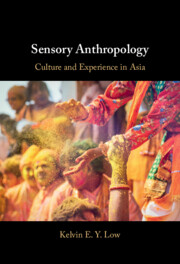Book contents
- Sensory Anthropology
- Sensory Anthropology
- Copyright page
- Dedication
- Contents
- Acknowledgements
- Introduction: How the Senses Are Good to Think With
- Part I Perspectives and Precepts
- Part II Responses and Restitutions
- 3 Sensory Transnationalism and Interfaces
- 4 Gastropolitical Encounters
- 5 Extreme Sensescapes
- Conclusion: Thinking through the Senses
- Notes
- References
- Index
5 - Extreme Sensescapes
from Part II - Responses and Restitutions
Published online by Cambridge University Press: 02 March 2023
- Sensory Anthropology
- Sensory Anthropology
- Copyright page
- Dedication
- Contents
- Acknowledgements
- Introduction: How the Senses Are Good to Think With
- Part I Perspectives and Precepts
- Part II Responses and Restitutions
- 3 Sensory Transnationalism and Interfaces
- 4 Gastropolitical Encounters
- 5 Extreme Sensescapes
- Conclusion: Thinking through the Senses
- Notes
- References
- Index
Summary
I ask in this chapter how embodied memories of violence and survival are captured through the various sensory reconstructions of war as a sensuous world of bodily transgressions. War affects a person’s sensibilities through the engendering of a shift in sense perception owing to unexpected turns of events. I consider how a repertoire of different genres of social texts about war and violence – from songs, letters, and poetry, to autobiographies, oral histories and others – form rich and sensuous repositories. These texts undergird how multiple facets and first-hand experiences of horror and disbelief are enacted through sensory modalities that either work individually or intersectionally. As much as the sensory provide vital clues for what might happen next – in one’s home, in the prison, or at a concentration centre – the sensory also strikes fear and anxiety on what the next course of action might be. By drawing upon ontological security theory, I show how these transpire within possible or potential recourse in differing contexts of precariousness. The senses therefore serve as a potent catalyst as they both incite fear and insecurity, but also latently security and some stability as they provide cues and information for social actors.
Keywords
- Type
- Chapter
- Information
- Sensory AnthropologyCulture and Experience in Asia, pp. 124 - 160Publisher: Cambridge University PressPrint publication year: 2023

